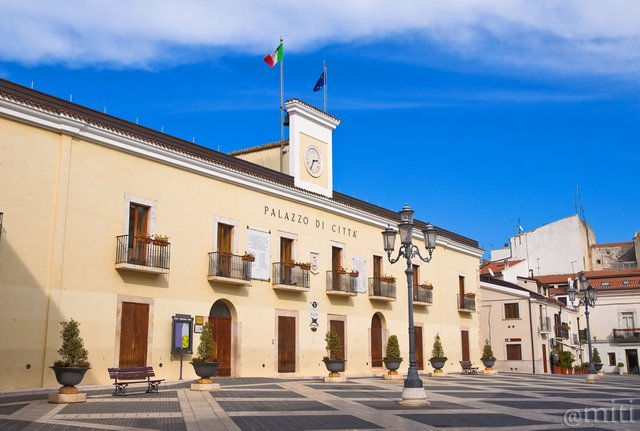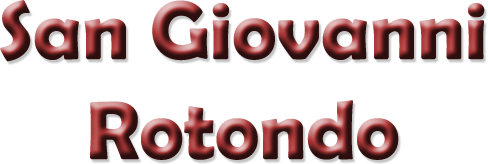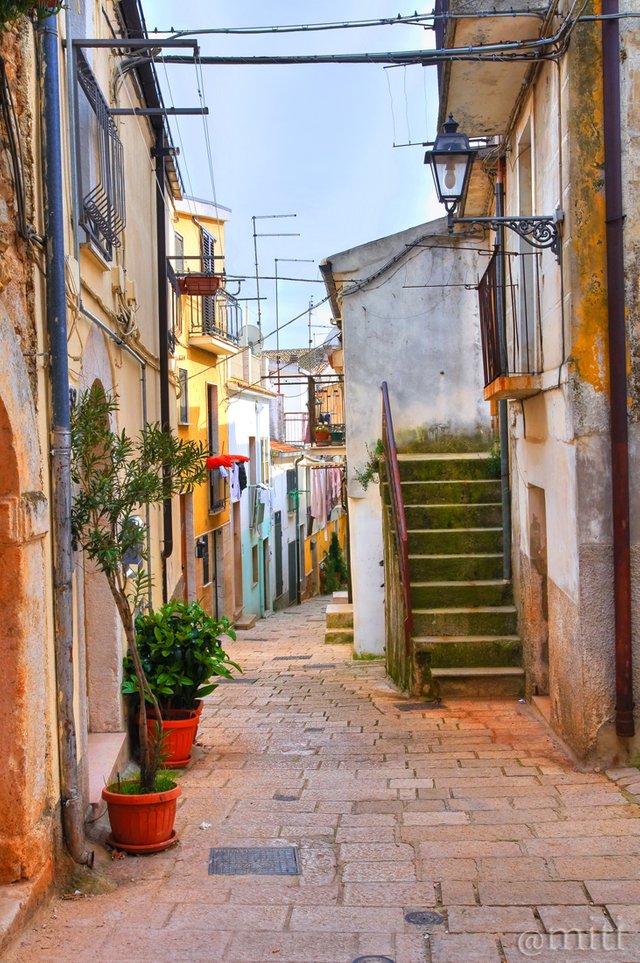A Journey through Italy: one photo every day #138 - SAN GIOVANNI ROTONDO [ENG/ITA]

The Town Hall Building (Author's photo - All rights reserved)
Il palazzo Comunale (Immagine dell'autore - tutti i diritti sono riservati)


Ciao a tutti,
questo è un viaggio attraverso l'Italia. Posterò una foto al giorno con una brevissima descrizione. Spero vi piaccia!

San Giovanni Rotondo è un piccolo borgo della provincia di Foggia, nella regione italiana meridionale della Puglia. Il paese si trova in una valle, alta 600 metri, nel promontorio del Gargano ed è famosa in tutto il mondo grazie al carismatico San Pio da Pietrelcina, che attira migliaia di fedeli.
Secondo studi recenti le origini di San Giovanni Rotondo sono molto antiche; in questo senso, sembra che San Giovanni Rotondo sia originato da antichi insediamenti e nel IV-III secolo aC il villaggio era stato romanizzato.
La città fu fondata nel 1055 sulle rovine di un precedente villaggio italico del VI secolo aC, dove si trovava un tempio rotondo (dal quale deriva il nome Rotondo), probabilmente dedicato al culto di Giano, il dio bifronte. Per tutto il Medioevo fu un importante centro amministrativo.
Successivamente, l'imperatore Federico II di Svevia (1194-1250) fortificò la città e la cinse con mura e torri. Dopo gli Svevi, la città passò agli Angioini e verso la fine del XIII secolo fu donata dal monastero di San Giovanni in Lamis in enfiteusi (una sorta di contratto di affitto) a un signore feudale francese, T. Helamant.
Quindi, San Giovanni Rotondo fu dominato dagli Aragonesi e nel 16 ° secolo fu il centro della lotta tra Spagna e Francia per il dominio in Italia.
La storia recente del borgo è quasi identificata con la vita e i miracoli di Francesco Forgione (25 maggio 1887 - 23 settembre 1968), canonizzato San Pio da Pietrelcina, che si unì all'Ordine dei Frati Minori Cappuccini ed era popolarmente noto come Padre Pio e visse a San Giovanni dal 1916 fino alla morte.
Nel centro storico c'è un'atmosfera unica e magica. Il tempo qui sembra essersi fermato. Le stradine sono intrecciate in un labirinto di vicoli, ci sono piante ornamentali su balconi, "mugnali" (scale esterne) e molti piccoli dettagli pieni di fascino e storia. Torri, palazzi, antiche chiese e monumenti.
Tra il XVI e il XVII secolo iniziarono le opere per la costruzione del monastero francescano di Santa Maria delle Grazie, una struttura monastica. Lo stile della chiesa è molto semplice con chiari riferimenti allo stile romanico. La facciata è in travertino e ha una forma rettangolare divisa da due file di colonne monolitiche.
Dopo la morte di Padre Pio, i suoi fratelli costruirono il nuovo Santuario dedicato a San Pio a San Giovanni Rotondo per accogliere un afflusso di credenti e incaricarono un importante architetto moderno, Renzo Piano, di progettarlo.
La chiesa è veramente monumentale e probabilmente ha poco in comune con quello che ti aspetti da una cattedrale in una città italiana.
La Chiesa di San Giovanni Battista diede alla città il suo nome grazie alla sua forma rotonda. Questa chiesa fu probabilmente un battistero nel VII o VIII secolo e fu costruita su basi ancora più antiche, forse un antico tempio di Giano.
La Chiesa di Sant'Orsola, risalente al XVIII secolo, ha una facciata esterna in stile barocco-rococò ed è adornata con belle statue e stucchi mentre l'interno è decorato con affreschi a tempera.
La Chiesa di Santa Eremita di Onofrio, nei pressi della città, risale al XIV secolo e presenta una facciata gotica completa di un rosone e un portale con un arco lavorato a rilievo con foglie d'acanto su due leoni sorretti da due colonne.
La città fa parte del percorso di pellegrinaggio attraverso il Gargano e attrae milioni di pellegrini ogni anno a causa della tomba di Padre Pio (1887-1968).
Cosa vedere: il Centro Storico, il Monastero Francescano di Santa Maria delle Grazie, il nuovo Santuario dedicato a San Pio, la Chiesa di San Giovanni Battista, la Chiesa di Sant'Orsola, la Chiesa di Sant'Onofrio Eremita, il Municipio, la Cappella Madonna di Loreto, la Chiesa di San Giuseppe, la Chiesa di San Nicola, la Chiesa di Santa Caterina.

Hello everyone,
I began a Photo Journey through Italy. I will post one photo every day with a little note of explanation. I hope you like it!

San Giovanni Rotondo is a small town in the province of Foggia, in the southern Italian region of Puglia. The town lies in a valley, 600 metres in height, in the Gargano promontory and it is famous all over the world thanks to the charismatic Saint Pio from Pietrelcina, who draws thousands of believers.
According to recent studies the origins of San Giovanni Rotondo are very old; in this sense, it seems that San Giovanni Rotondo is derived from ancient settlements, and in the 4th-3rd century BC the village had been Romanized.
The town was founded in 1055 on the ruins of a previous Italic village of the 6th century BC, where a round temple (from which the name Rotondo) was extant, probably devoted to the worship of Janus, the two-faced god. Throughout the Middle Ages it was an important administrative center.
Later, the Emperor Frederick II of Swabia (1194-1250) fortified the town and surrounded it by walls and towers. After the Swabians, the city passed to the Angevin, and towards the end of the 13th century it was given by the Monastery of San Giovanni in Lamis in emphyteusis (a sort of lease agreement) to a French feudal lord, T. Helamant.
Then, San Giovanni Rotondo was dominated by the Aragonese and in the 16th century it was the center of the struggle between Spain and France for dominance in Italy.
The recent history of the place is almost identified with the life and miracles of Francesco Forgione (May 25, 1887 - September 23, 1968), canonized Saint Pio of Pietrelcina, who joined the Order of Friars Minor Capuchin and was popularly known as Padre Pio, and lived in San Giovanni from 1916 to his death.
In the historical center there is unique and magical atmosphere. The time here seems to have stopped. The narrow streets are entwined in a maze of alleys, there are ornamental plants on balconies and “mugnali” (external staircases) and many small details filled with charm and history. Towers, palaces, ancient churches and monuments.
Between the 16th and 17th centuries work started on the Franciscan Monastery of Santa Maria delle Grazie, a monastic structure. The style of the church is very simple with clear references to the Romanesque style. The façade is in travertine and a rectangular shape divided by two rows of monolithic columns.
After the death of Padre Pio his brothers built the new Church of Padre Pio in San Giovanni Rotondo to accommodate an influx of believers, and commissioned a leading modern architect, Renzo Piano, to design it.
The church is truly monumental and probably has little in common with what you expect from a cathedral in an Italian town.
The Church of Saint John the Baptist gave the city its name due to its round shape. This church was probably a baptistery in the 7th or 8th century and was built on even more ancient foundations, perhaps an ancient temple of Janus.
The Church of Saint Ursula, dating from the 18th century has an external façade in the Baroque-Rococo style is adorned with fine statues and stucco while its interior is decorated with frescoes in tempera.
The Church of Saint Hermit Onofrio near the city dates back to the 14th century, and has a Gothic façade complete with a rose window and a portal with a bow worked in relief with acanthus leaves resting on two lions supported by two columns.
The town is part of the pilgrimage route across Gargano, and attracts millions of pilgrims each year because of the tomb of Padre Pio (1887-1968), a miracle worker who was made a saint in 2002.
Thing to see: the Historical centre, the Franciscan Monastery of Santa Maria delle Grazie, the new Shrine dedicated to Saint Pio, the Church of Saint John the Baptist, the Church of Saint Ursula, the Church of Saint Hermit Onofrio, the Town Hall, the Chapel Madonna di Loreto, the Church of San Giuseppe, the Church of San Nicola, the Church of Santa Caterina.
| Tipo di foto / Category | Paesaggio / Landscape view |
| Esposizione / Settings | 1/320 sec, ISO 200, f/10 |
| Camera | Nikon D5000 |
| Lente / Lens | Tamron SP 17-50mm f/2.8 XR Di II LD |
| Filtro / Filter | Polarizzatore Hoya / Hoya Polarizing filter |
| Cavalletto / Tripod | Manfrotto MKC3-P01 |
| Località / Location | San Giovanni Rotondo (Foggia), Italia |
| Software | Photoshop |

Alleyway in the historical center (Author's photo - All rights reserved)
Vicolo del centro storico (Immagine dell'autore - tutti i diritti sono riservati)


Bellissimo San Giovanni rotondo!!
E anche molto mistico.. il santuario di San Pio è emozionante.
Congratulations, Your Post Has Been Added To The Steemit Worldmap!
Author link: http://steemitworldmap.com?author=miti
Post link: http://steemitworldmap.com?post=a-journey-through-italy-one-photo-every-day-138-san-giovanni-rotondo-eng-ita
Want to have your post on the map too?
so beautiful!!
please two or three pictures every day!
Thanks.. but if you look close enough, there are already two pictures!
as always amazing stuff
So beautiful photography
Thanks.
You got a 32.12% upvote from @ocdb courtesy of @miti!
The picture of Alleyway is awesome!
Thanks!
Is that the area where witches were massacred in the dark ages?
Posted using Partiko Android
The witches were hunted in the area which today is Europe.
Follow me and encourage me to see my content, it is very entertaining
Your comment is considered SPAM... Take a look in this guide:
https://steemit.com/steemit/@miti/a-complete-guide-for-newcomers-and-minnows-to-avoid-a-possible-spam-and-to-write-good-comments
It will help you.
Wao
AMAZING photos thank you for sharing, please can you follow me to help me grow. Thank you so much @zipp03
Your comment is considered SPAM... Take a look in this guide:
https://steemit.com/steemit/@miti/a-complete-guide-for-newcomers-and-minnows-to-avoid-a-possible-spam-and-to-write-good-comments
It will help you.
Thanks
I have just read it and it was very useful and I appreciate it, thank you for saving me from becoming one of those annoying people who just writes comments to try and get followers. I realise that it must have taken a lot of time to write that post so thank you.